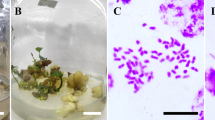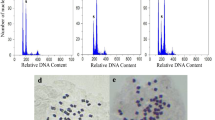Abstract
Polyploidy breeding has proved to be a valuable approach for acquiring the high yield superior varieties in medicinal plants. An effective protocol for obtaining Bletilla striata autotetraploid is in vitro induction of protocorms with colchicine. The protocorms of B.striata were soaked in different concentrations of colchicine solution [0.05, 0.1 and 0.2% (w/v)] for 12, 24, 36, 48 and 60 h, and the ploidy of the seedlings was identified by chromosome counting and flow cytometry analysis. The results showed that the optimal condition for induction of autotetraploid of B. striata protocorms was treated with 0.2% colchicine for 36 h with the induction rate reached as high as 26.7%. In addition, the morphological and anatomical characteristics were observed and compared between the diploid and tetraploid plants. And we found that the features of tetraploid plants were significantly different from diploid plants, such as tetraploid plants possessed thicker and deeper green leaves, larger stomata and more chloroplast number, which could be used as simple and efficient parameters for screening tetraploid. This study laid a foundation for breeding superior varieties of B. striata.



Similar content being viewed by others
References
Bonten MJ, Huijts SM, Bolkenbaas M, Webber C, Patterson S, Gault S, van Werkhoven CH, van Deursen AM, Sanders EA, Verheij TJ (2015) Polysaccharide conjugate vaccine against pneumococcal pneumonia in adults. N Engl J Med 372(12):1114–1125
Chen LL, Gao SL (2007) In vitro tetraploid induction and generation of tetraploids from mixoploids in Astragalus membranaceus. Sci Hortic 112(3):339–344
Chen M, Wang F, Zhang Z, Fu J, Ma Y (2017) Characterization of fungi resistance in two autotetraploid apple cultivars. Sci Hortic 220:27–35
Clarke J (1960) Preparation of leaf epidermis for topographic study. Stain Technol 35(1):35–39
Commission CP (2015) Pharmacopoeia of the People’s Republic of China. China Medical Science and Technology Press, Beijing
Cui Y, Hou L, Li X, Huang F, Pang X, Li Y (2017) In vitro induction of tetraploid Ziziphus jujuba Mill. var. spinosa plants from leaf explants. Plant Cell Tissue Organ Cult 131(1):175–182
Dhooghe E, Van Laere K, Eeckhaut T, Leus L, Van Huylenbroeck J (2011) Mitotic chromosome doubling of plant tissues in vitro. Plant Cell Tissue Organ Cult 104(3):359–373
Galbraith DW, Harkins KR, Maddox JM, Ayres NM, Sharma DP, Firoozabady E (1983) Rapid flow cytometric analysis of the cell cycle in intact plant tissues. Science 220(4601):1049–1051
Gallagher JP, Grover CE, Hu G, Wendel JF (2016) Insights into the ecology and evolution of polyploid plants through network analysis. Mol Ecol 25(11):2644–2660
Gantait S, Mandal N, Bhattacharyya S, Das PK (2011) Induction and identification of tetraploids using in vitro colchicine treatment of Gerbera jamesonii Bolus cv. Sciella. Plant Cell Tissue Organ Cult 106(3):485–493
Gao SL, Zhu DN, Cai ZH, Xu DR (1996) Autotetraploid plants from colchicine-treated bud culture of Salvia miltiorrhiza Bge. Plant Cell Tissue Organ Cult 47(1):73–77
Jing YE, Zheng XJ, Guan CD, Niu Y, Hai-Ying MA (2010) Seed germination and tissue culture of Bletilla striata. J Yunnan Univ 5:383–390
Kaensaksiri T, Soontornchainaksaeng P, Soonthornchareonnon N, Prathanturarug S (2011) In vitro induction of polyploidy in Centella asiatica (L.) urban. Plant Cell Tissue Organ Cult 107(2):187–194
Kerdsuwan N, Techato S (2012) Effects of colchicine on survival rate, morphological, physiological and cytological characters of chang daeng orchid (Rhynchostylis gigantean var. rubrum Sagarik) in vitro. Chato
Lewis WH (1980) Polyploidy in species populations polyploidy. Springer, New York, pp 103–144
Li R, Wang ZZ (2006) Research survey and countermeasure on resources utilization in stem tuber of Bletilla striata. Chin Tradit Herbal Drugs 37(11):1751–1755
Lu M, Zhang PD, Wang J, Kang XY, Wu JY, Wang XJ, Chen Y (2014) Induction of tetraploidy using high temperature exposure during the first zygote division in Populus adenopoda Maxim. Plant Growth Regulat 72(3):279–287
Lv XB, Huang CQ, Wu ZC, Yang DJ, Lin D (2012) The therapeutic effects of polysaccharides from Bletilla Striata on gastric ulcer rats. J Yunnan Univ Tradit Chin Med 33(3):35–37
Meng Z (2008) On the sustainable use of traditional Chinese medicine resources. Sci Technol Rev 26(14):40–47
Mergen F, Lester DT (1961) Colchicine-induced polyploidy in abies. Forest Sci 4:314–319
Murashige T, Skoog F (1962) A revised medium for rapid growth and bio assays with tobacco tissue cultures. Physiol Plant 15(3):473–497
Nilanthi D, Chen XL, Zhao FC, Yang YS, Wu H (2014) Induction of tetraploids from petiole explants through colchicine treatments in Echinacea purpurea L. J Biomed Biotechnol 2009:343485
Ochatt S, Patat-Ochatt E, Moessner A (2011) Ploidy level determination within the context of in vitro breeding. Plant Cell Tissue Organ Cult 104(3):329–341
Pansuksan K, Sangthong R, Nakamura I, Mii M, Supaibulwatana K (2014) Tetraploid induction of Mitracarpus hirtus L. by colchicine and its characterization including antibacterial activity. Plant Cell Tissue Organ Culture 117(3):381–391
Peng F, Zhang S, Liu TS, Xiao BM (2002) Determination of imperatorin in tetraploidy radix Angelicae dahuricae. J Chin Mater Med 27(6):426–427, 459
Pereira LDP, Mota MR, Brizeno LA, Nogueira FC, Ferreira EG, Pereira MG, Assreuy AM (2016) Modulator effect of a polysaccharide-rich extract from Caesalpinia ferrea stem barks in rat cutaneous wound healing: role of TNF-α, IL-1β, NO, TGF-β. J Ethnopharmacol 187:213–223
Rong LP (2007) Studies on technique of chromosome squashing of root-tip in Lilium lancifolium Thunb. J Anhui Agric Sci 35(7):256–258
Rowson JM (1944) Increased alkaloidal contents of induced polyploids of datura. Nature 154(3898):81–82
Shao J, Chen C, Deng X (2003) In vitro induction of tetraploid in pomegranate (Punica granatum). Plant Cell Tissue Organ Cult 75(3):241–246
Song C, Liu SJ, Xiao J, He WG, Zhou Y, Qin QB, Zhang C, Liu Y (2012) Polyploid organisms. Sci China Life Sci 55(4):301–311
Speckmann G, Post J, Dijkstra H (1965) The length of stomata as an indicator for polyploidy in rye-grasses. Euphytica 14(3):225–230
Sun DF, Shi JS, Zhang WM, Gu GP, Zhu CL, Xue HM (2009) Research progress on polysaccharide gum of Bletilla striata (Thunb.) Reichb. f. Food Sci 3:068
Tan FQ, Tu H, Liang WJ, Long JM, Wu XM, Zhang HY, Guo WW (2015) Comparative metabolic and transcriptional analysis of a doubled diploid and its diploid citrus rootstock (C. junos cv. Ziyang xiangcheng) suggests its potential value for stress resistance improvement. BMC Plant Biol 15(1):89
Tang Z-Q, Chen D-L, Song Z-J, He Y-C, Cai D-T (2010) In vitro induction and identification of tetraploid plants of Paulownia tomentosa. Plant Cell Tissue Organ Cult 102(2):213–220
Tu PF (2006) Development and research ideas of pharmacognosy. Chin J Nat Med 4(6):411–419
Wang C-y, Lin H-m, Liu J-y, Cai P-l, Liu Y-l (2011) The Experimental research on antiulcer action of Bletilla pseudobulb polysaccharides. Inform Tradit Chin Med 2:006
Widoretno W (2016) In vitro induction and characterization of tetraploid Patchouli (Pogostemon cablin Benth.) plant. Plant Cell Tissue Organ Cult 125(2):261–267
Xin PY (2008) Study on the squashing technique of chromosome in Cannabis sativa L. J Anhui Agric Sci 36(1):26–23
Yuan N, He J, He R, Li P, Ye L, Wang H, Zhuo B (2009a) Tissue culture and rapid propagation of Bletilla striata. Southwest China J Agric Sci 22(3):781–785
Yuan N, Jun-Rong HE, Rui HE, Ping LI, Lan-Xiang YE, Wang HE, Zhuo BP (2009b) Tissue culture and rapid propagation of Bletilla striata. Southwest China J Agric Sci 22(3):781–785
Zhang FW, Wang YR (2006) Progress of polyploidy breeding technology applied in medical plants scale. Guiding J TCM 12:83–85
Zhang QY, Luo FX, Liu L, Guo FC (2010) In vitro induction of tetraploids in crape myrtle (Lagerstroemia indica L.). Plant Cell Tissue Organ Cult 101(1):41–47
Author information
Authors and Affiliations
Contributions
XZ conceived and designed the experiments. Experiments were performed by HP and LH. Data analysis were performed by LW. All authors participated into paper writing.
Corresponding author
Ethics declarations
Conflict of interest
Authors have nothing to disclose with regard to commercial support.
Additional information
Communicated by Sergio J. Ochatt.
Rights and permissions
About this article
Cite this article
Pan-pan, H., Wei-xu, L., Hui-hui, L. et al. In vitro induction and identification of autotetraploid of Bletilla striata (Thunb.) Reichb.f. by colchicine treatment. Plant Cell Tiss Organ Cult 132, 425–432 (2018). https://doi.org/10.1007/s11240-017-1339-8
Received:
Accepted:
Published:
Issue Date:
DOI: https://doi.org/10.1007/s11240-017-1339-8




